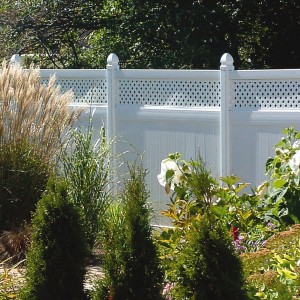
A solid privacy vinyl fence with a decorative top section creates an efficient windbreak to reduce convective heat loss from a home. Photo by Genova Products
I plan to hire a contractor to make a few efficiency improvements to my home. I would like a better understanding of how a home loses and gains heat so that I am not persuaded into unnecessary projects. Can you help?
It never hurts to arm yourself with as much knowledge as possible about the projects you are considering. Using just a few of the proper terms and displaying some knowledge can keep a contractor from attempting anything unnecessary or unethical. Keep in mind, you will not know if the improvements helped until next year’s utility bills arrive.
There are many DIY books about efficiency improvements, which would be a great starting point. Each home is unique though, so what some books recommend in general may not provide the best payback for your specific living space.
Don’t forget to call your local electric co-op. Most co-ops have professionals on staff who can help educate you about energy efficiency and either offer energy audits or can point you to trustworthy folks in your community who will conduct a thorough audit.
The most common misconception about a home is that heat rises. Heat does not actually rise. Instead, heat, which is a form of energy, flows equally in all directions. What does rise is warm air because it is less dense than cool air. This is important to keep in mind when determining where, how much and what types of insulation to use for various areas of your home.
The basic types of heat flow, out of your home during winter or into it during summer, are conduction, convection, radiation and air infiltration (leakage). Conduction is probably the most common type. This is how the handle on a cup gets hot from the coffee, or how heat flows through the wood studs inside the walls.
The amount of heat lost or gained from conduction is primarily a function of the temperature difference between the indoor and outdoor surfaces of an outside wall. If the outdoor temperature drops so that the temperature difference is twice as large, twice as much heat will be lost through the wall.
The insulation level of a home also affects heat loss. If the insulation R-value is doubled, the amount of heat loss is cut in half.
Convection refers to heat flow from a fluid, such as air or water, moving over a surface. The heat lost by convection will also double if the temperature difference doubles, but it will increase even more as the air blows faster. This is what causes a wind chill factor during winter months.
Radiation is heat flow, which moves through space or air. This is how the sun warms us. Just as it warms you, your home also loses radiant heat to the outdoors, especially on a clear cold night.
Radiant heat flow is different in that when the temperature difference is doubled, the heat flow increases by 16 times.
Now that you have this background knowledge, make a list of problem areas, such as a persistently chilly room. If the room is located on the northwest side of the home, convection losses and air infiltration from winter winds could be a factor. Erecting some type of windbreak — a privacy fence or even planting evergreen trees — can help.
Since heat moves down as well as up, check the lumber band joist, which rests on the foundation. If it is not insulated, which is not uncommon, much heat can be lost by conduction moving out of it. If this is the case, I recommend insulating the joint. While the insulation is being installed, caulk where the joist rests on the top of the foundation. This spot is often uneven and leaks air.
Installing shades and closing them at night can block the direct radiant heat flow to the cold night sky or from the hot afternoon sun. This is much less expensive than installing new windows. Have low-emissivity, reflective foil stapled under the roof rafters. This dramatically reduces the radiant heat flow downward on hot summer afternoons.
James Dulley is a nationally syndicated engineering consultant based in Cincinnati. If you have a question about energy use or energy-efficient products, send it to: James Dulley, Electric Consumer, 6906 Royalgreen Drive, Cincinnati, OH 45244; or visit www.dulley.com.



